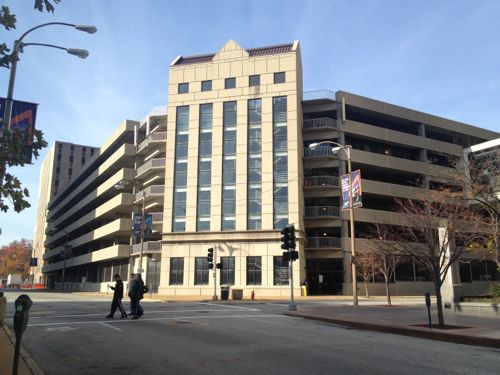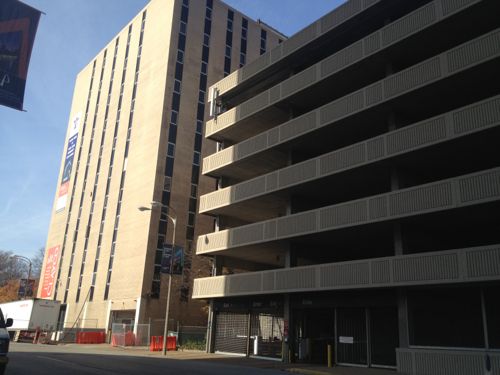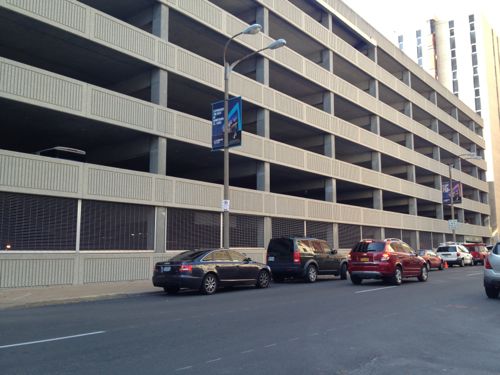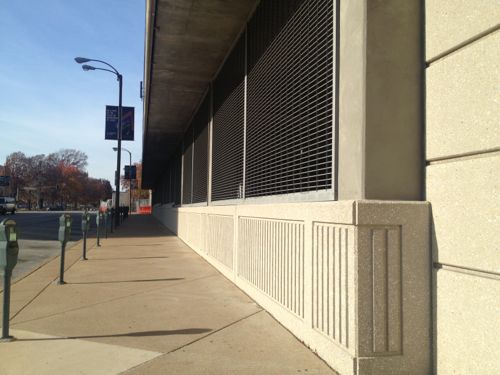Idea: Retail Retrofit To AT&T’s Parking Garage
Today parking garages are built with retail on the first floor so they are have potential activity at the sidewalk level. Unfortunately, we still have many garages built in earlier times when no provisions were made for anything other than the storage of cars. Some, like the 1960s stadium garages, can’t easily be retrofitted, see Fixes For Stadium West, Stadium East. The AT&T parking garage at 1101 Chestnut, built in 1985, can be retrofitted with retail.

Before anyone says something like ‘the city has bigger problems for its limited resources’ let me state this post is about trying to repair one small section our city by showing a way a corporate citizen can help out by modifying their private property . Why would they? Because they like to be seen as a good corporate citizen.
Any need?
Yes, anyone that has ever had jury duty across the street knows finding a place for lunch isn’t too easy close by. Saint Louis University Law School will soon be located in the building adjacent to the west end of the garage.



This wouldn’t require 100% of the ground floor, although most of the south side facing Chestnut would be a good concentration facing the courthouse. The small area facing 11th and the long area facing Pine could be done later as demand increases.
Again, I’m not advocating public monies be spent on this effort. I also don’t think AT&T is going to start work on implementing this idea right away, or ever. It’s an idea I thought I’d stare because I think it could have a positive impact on the activity level in the area.
— Steve Patterson
Quite interesting facade for a parking garage.
I assume that to install retail in such a building, you must remove some of the parking spaces to make room. Is the garage often full enough that removing some spaces would be a problem? Is a certain parking space count necessary to meet zoning requirements?
Bigger picture, we can’t spend our way to prosperity. St. Louis’ current office vacancy rate is 17.7% (compared to the national average of slightly more than 14%). For retail to thrive, be it in existing storefronts, new storefronts in old garages or new storefronts in new structures, we need to attract more CUSTOMERS! The majority of customers in downtown are a) workers / employees, b) downtown residents and c) out-of-town visitors. The best way to have significantly more customers downtown is to have significantly more office workers – make downtown a great place to work, better than Clayton, better than Chesterfield, better than Westport. Just building more storefronts, with no viable uses, would be a waste of time and money. And getting back to your original premise, that jurors and law students are / would be great customers, I’d argue that if the demand were there from the jury pool, it would have already been met, and college students generally have limited disposable income.
“make downtown a great place to work”
How?
“college students generally have limited disposable income”
Maybe it depends on the college, but my peers (though not myself) had loads of disposable income in college.
“How?” That’s precisely my question! Converting upper levels of existing buildings to residential, converting street-level spaces to retail and reducing parking do nothing to address the employment side of the equation. Great downtowns are also robust employment centers, not just glorified shopping malls . . . .
This parking garage isn’t going anywhere as it is used by AT&T employees so I fail to see how converting the street level to retail will hurt anything?
If there are/will be viable tenants, absolutely, it would be a good thing! My point is questioning if there is any demand? We already have multiple vacant retail spaces downtown. Is there any real need to add / create even more? What it all boils down to is a Hobson’s choice – which is worse? Vacant, street-level retail space or an occupied parking garage, with spaces visible from the sidewalk?
Great idea Steve. Of all the AT&T buildings that would be the easiest to retrofit.
Someone should call the alderman and request that she approach the building owner to make this happen.
I believe the market will seek out what SLU brings to the table with its law school one way or another, maybe a savy owner of a garage has the same thoughts as Steve has in mind. Who knows, maybe that owner in this case already has a perliminary market study, budget costs underway way while SLU is doing its rehab. Or maybe a local developer will be the only one to submit a proposal on a empty former muni courts building not to far away with street level retail proposed for a parking garage.
Steve suggests a good idea for a particular property downtown and JZ71 reminds us that market will find its way when the demand is there. The key of course, get people downtown one way or another.
The idea that the market naturally fills all voids is just not true though, many can’t see retail spaces on the ground floor of what’s been nothing but lifeless car storage for the past 27 years. Put retail there, or even signs of retail coming soon, and many will say “oh I’d have never thought of that.”
Or there may be more demand for convenient, next-door parking, from both staff and students. Yes, several hundred “new” Bilikens will certainly increase demand, the only question is what form it may take . . . .
How do you know if it hasn’t been thought of? Maybe the owner has taken a look at and also sees that parking garages build recently in the immediate area have built out retail space only to see it space sit empty. Maybe the owner asked a local broker to do count on available space for lease, what the current lease rates are and what if any incentives their is for a build out only to see revenue number that suggests a lost on investment.
Have to agree with GMichaud in some regards, yes on a purist basis there is no such thing true capitalism, Washington Avenue is a good case for his argument in some respects. But at the end of the day from your own real estate experience you must see that the simple basis of building out retail for the sake of a higher use or urban context still needs an economic case over time. Maybe in a couple of years, maybe longer. Yes it is a good idea in thought, but can you build it out at this time and draw a new tenant at lease that works? Can you do it without just getting a tenanat moving from one downtown building to another?
It may have been thought of at AT&T, but I see that as unlikely. As with a new project, you don’t build it then try to look for tenants. You shop around the concept to get a sense of interest, prepare drawings, sign a tenant or two, then build. This takes time and a commitment to creating more vibrant sidewalks.
Everything doesn’t come down to demand. St. Louisians did not demand a city that Is neither walkable or transit orientated. It came about because everything is designed for the auto with help from the oil, auto, tire, concrete and so on industries. The problem here is the same with the rest of the city, the lack of a unified policy that would surround this potential commercial site with walkability, transit and density. This site becoming a successful commercial district is heavily dependent on the surroundings.
What I can’t understand, after 60 years of the same failed policies that have resulted in the precipitous decline of the city, why are the same autocentric approaches still followed? That would be a good question to ask the two candidates for mayor, Slay and Reed.
I agree, completely, with your second statement. So far, we have two strong mayoral candidates. Perhaps, we’ll see one (or more) more-urban-focused ones emerge, as well.
If there was a true free market you might have a point. But between corporations buying government policy plus considerations like the fact auto’s don’t even begin to pay their true costs, the free market system is only an illusion.
Then this will be right up your alley: http://www.governing.com/columns/eco-engines/col-seoul-subway-offers-lesson-in-transportation.html